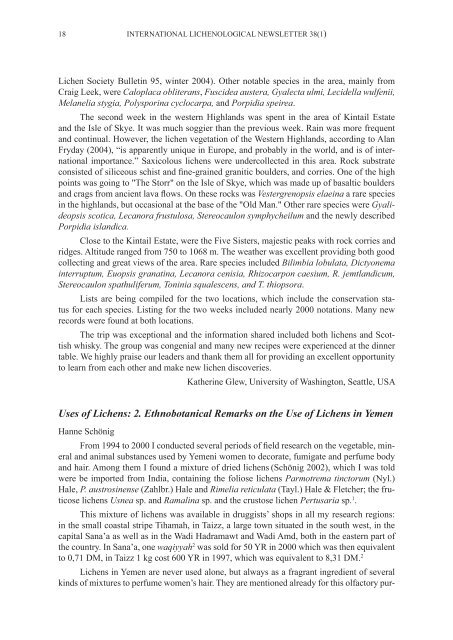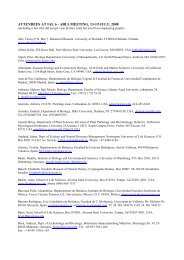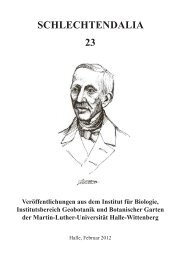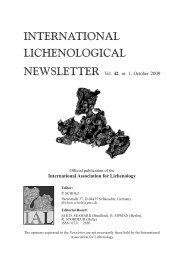NEWS - International Association for Lichenology
NEWS - International Association for Lichenology
NEWS - International Association for Lichenology
You also want an ePaper? Increase the reach of your titles
YUMPU automatically turns print PDFs into web optimized ePapers that Google loves.
18 INTERNATIONAL LICHENOLOGICAL <strong>NEWS</strong>LETTER 38(1)<br />
Lichen Society Bulletin 95, winter 2004). Other notable species in the area, mainly from<br />
Craig Leek, were Caloplaca obliterans, Fuscidea austera, Gyalecta ulmi, Lecidella wulfenii,<br />
Melanelia stygia, Polysporina cyclocarpa, and Porpidia speirea.<br />
The second week in the western Highlands was spent in the area of Kintail Estate<br />
and the Isle of Skye. It was much soggier than the previous week. Rain was more frequent<br />
and continual. However, the lichen vegetation of the Western Highlands, according to Alan<br />
Fryday (2004), “is apparently unique in Europe, and probably in the world, and is of international<br />
importance.” Saxicolous lichens were undercollected in this area. Rock substrate<br />
consisted of siliceous schist and fi ne-grained granitic boulders, and corries. One of the high<br />
points was going to "The Storr" on the Isle of Skye, which was made up of basaltic boulders<br />
and crags from ancient lava fl ows. On these rocks was Vestergrenopsis elaeina a rare species<br />
in the highlands, but occasional at the base of the "Old Man." Other rare species were Gyalideopsis<br />
scotica, Lecanora frustulosa, Stereocaulon symphycheilum and the newly described<br />
Porpidia islandica.<br />
Close to the Kintail Estate, were the Five Sisters, majestic peaks with rock corries and<br />
ridges. Altitude ranged from 750 to 1068 m. The weather was excellent providing both good<br />
collecting and great views of the area. Rare species included Bilimbia lobulata, Dictyonema<br />
interruptum, Euopsis granatina, Lecanora cenisia, Rhizocarpon caesium, R. jemtlandicum,<br />
Stereocaulon spathuliferum, Toninia squalescens, and T. thiopsora.<br />
Lists are being compiled <strong>for</strong> the two locations, which include the conservation status<br />
<strong>for</strong> each species. Listing <strong>for</strong> the two weeks included nearly 2000 notations. Many new<br />
records were found at both locations.<br />
The trip was exceptional and the in<strong>for</strong>mation shared included both lichens and Scottish<br />
whisky. The group was congenial and many new recipes were experienced at the dinner<br />
table. We highly praise our leaders and thank them all <strong>for</strong> providing an excellent opportunity<br />
to learn from each other and make new lichen discoveries.<br />
Katherine Glew, University of Washington, Seattle, USA<br />
Uses of Lichens: 2. Ethnobotanical Remarks on the Use of Lichens in Yemen<br />
Hanne Schönig<br />
From 1994 to 2000 I conducted several periods of fi eld research on the vegetable, mineral<br />
and animal substances used by Yemeni women to decorate, fumigate and perfume body<br />
and hair. Among them I found a mixture of dried lichens (Schönig 2002), which I was told<br />
were be imported from India, containing the foliose lichens Parmotrema tinctorum (Nyl.)<br />
Hale, P. austrosinense (Zahlbr.) Hale and Rimelia reticulata (Tayl.) Hale & Fletcher; the fruticose<br />
lichens Usnea sp. and Ramalina sp. and the crustose lichen Pertusaria sp. 1 .<br />
This mixture of lichens was available in druggists’ shops in all my research regions:<br />
in the small coastal stripe Tihamah, in Taizz, a large town situated in the south west, in the<br />
capital Sana’a as well as in the Wadi Hadramawt and Wadi Amd, both in the eastern part of<br />
the country. In Sana’a, one waqiyyah2 was sold <strong>for</strong> 50 YR in 2000 which was then equivalent<br />
to 0,71 DM, in Taizz 1 kg cost 600 YR in 1997, which was equivalent to 8,31 DM. 2<br />
Lichens in Yemen are never used alone, but always as a fragrant ingredient of several<br />
kinds of mixtures to perfume women’s hair. They are mentioned already <strong>for</strong> this olfactory pur-






